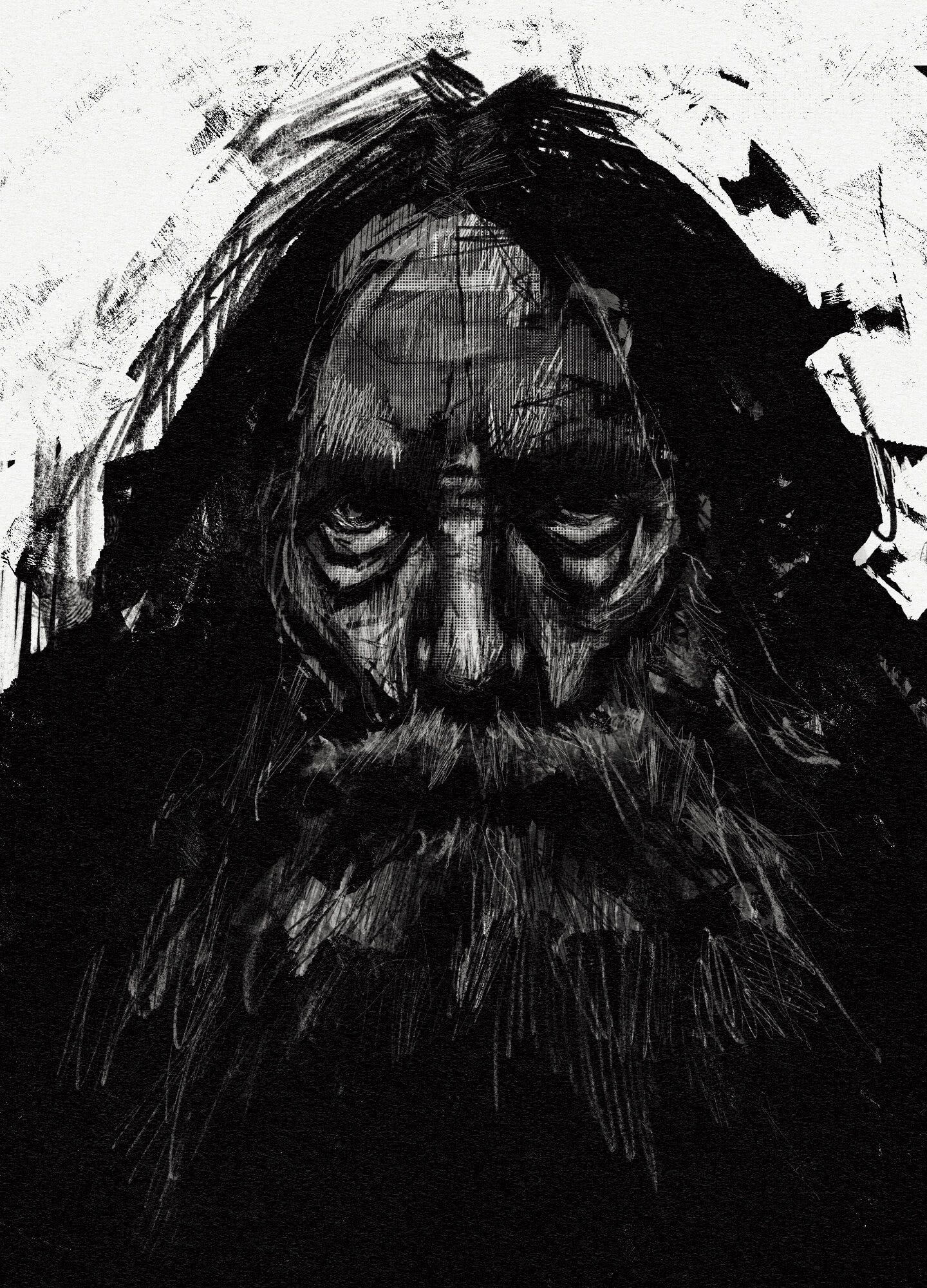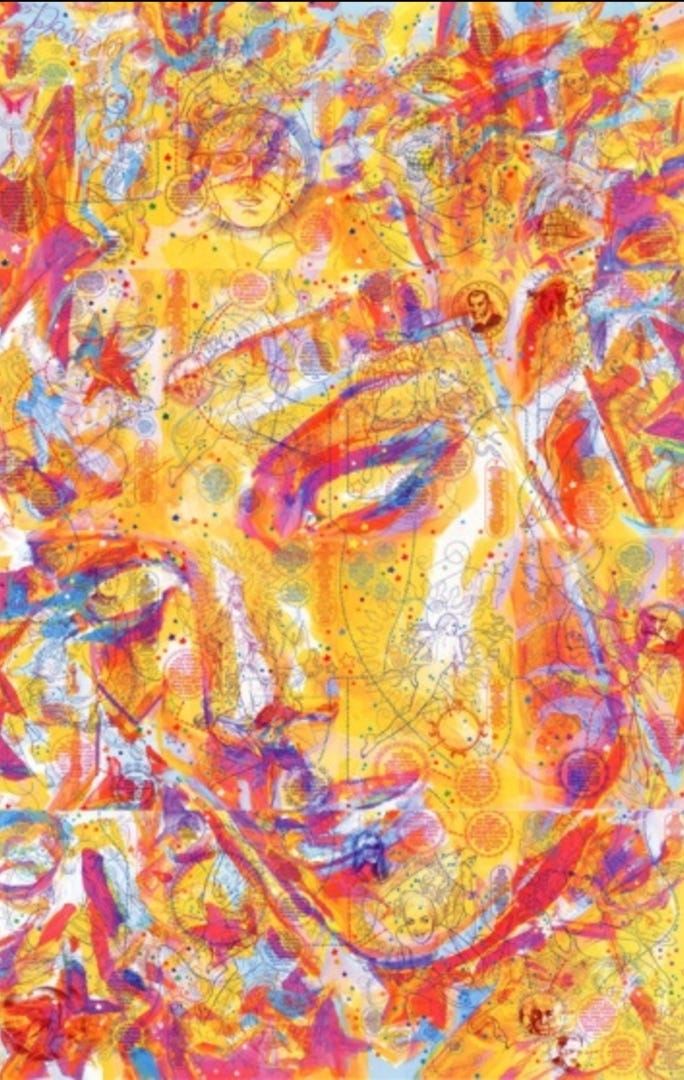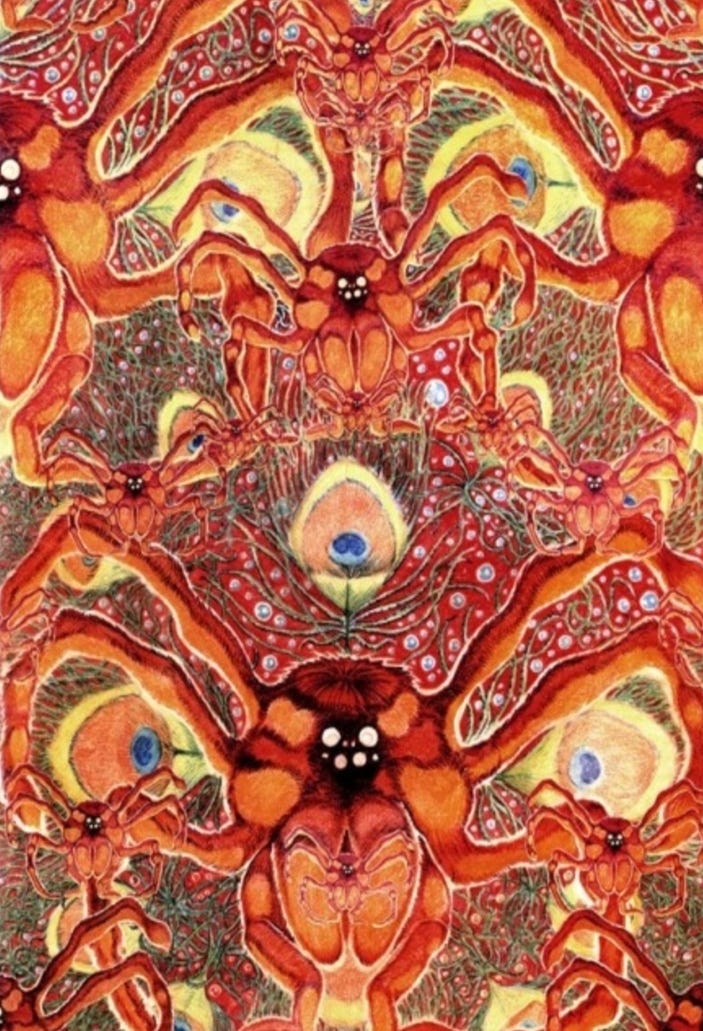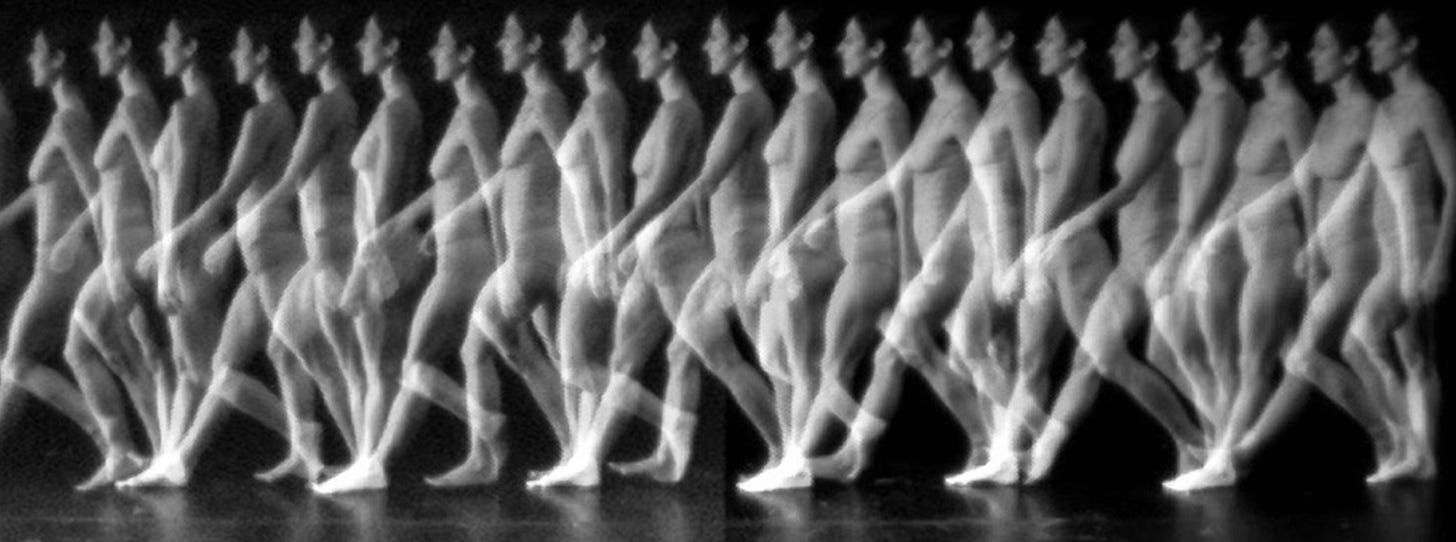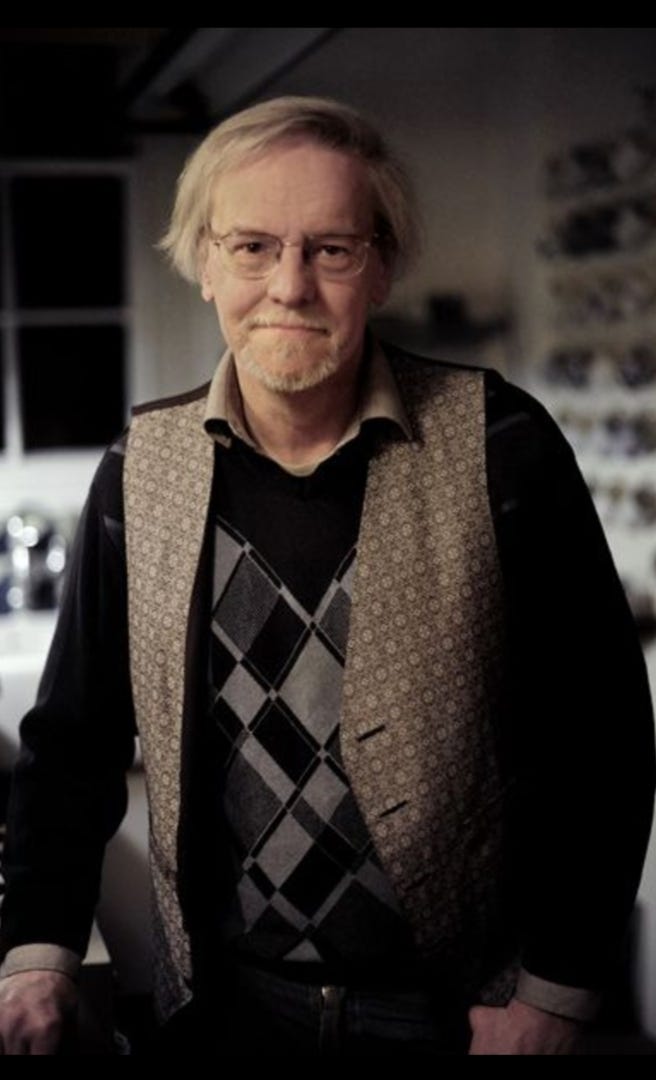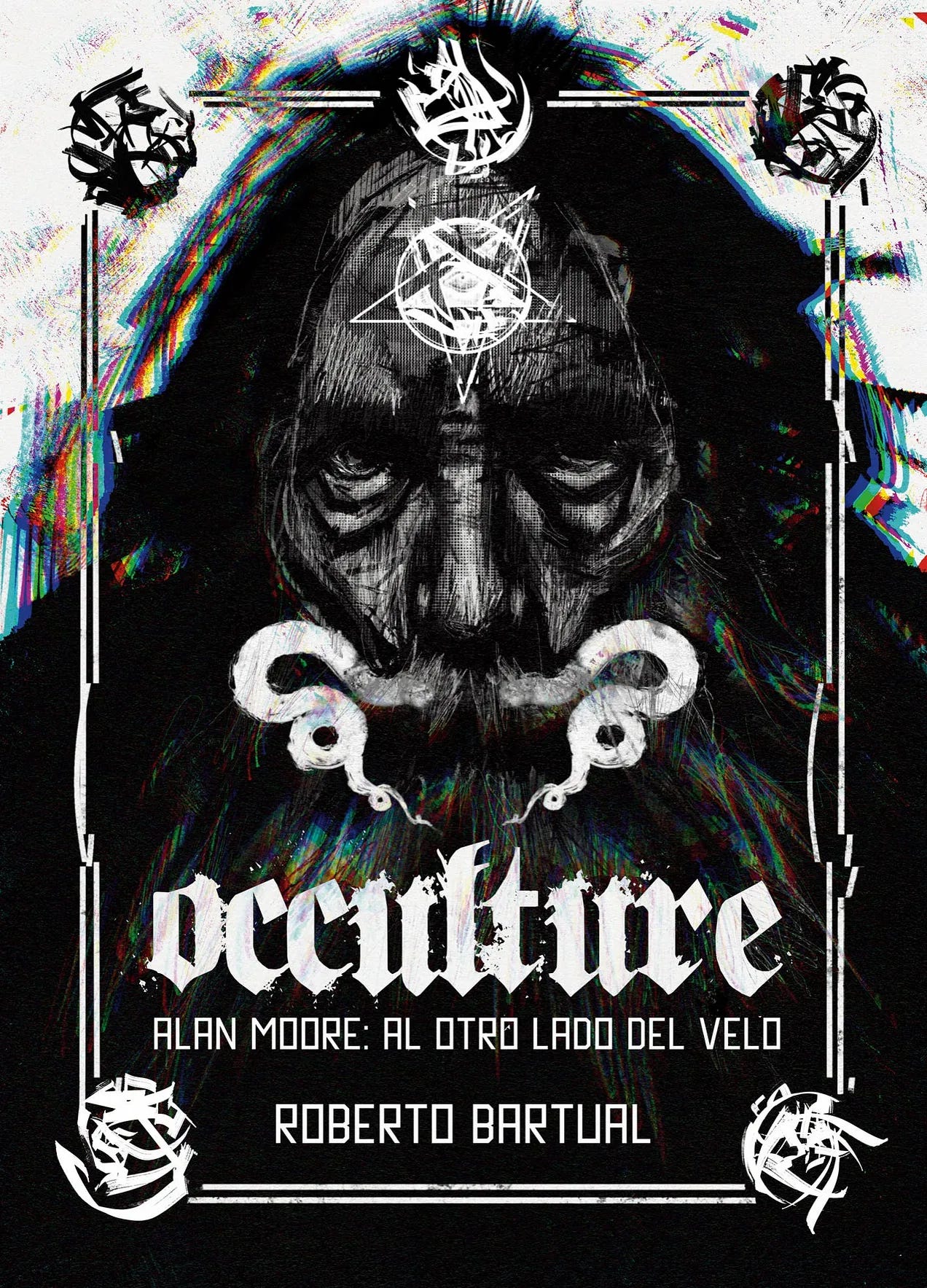Interview with Alan Moore
His relation with magic, psychedelic substances, ghosts and a chilling account of his friend Steve Moore's last goodbye. (May/June, 2025)
But first, some words about how this interview came into existence. I guess most of you are not regular readers of these blog/newsletter, since it’s always written in Spanish. Welcome, anyway. My name is Roberto Bartual. I write about comics, and have recently published a book about Alan Moore and his relation with occultism. It is beautifully illustrated by Manu Gutiérrez and its title is: Occulture. Alan Moore: Al otro lado del velo. It’s written in Spanish. I’m sorry, no translation to English yet. I hope an English-language publisher is interested soon.
Well, the thing is… when Manu and I finished the book, we said: why don’t we interview the man himself? We tried to contact him by all means known in the modern world to contact a human being. Through his publisher, through some of his former collaborators, friends, emails were sent, some phone calls… to no avail. So Manu and I had no other choice than… well, if the means known in the modern world did not work, why not try the means that DID work in the ANCIENT world? If they worked for Promethea… After all he IS Alan Moore.
So we wrote him a letter. We folded it. We put it inside an envelope, we sent it by mail, he received it, he answered it in a very friendly manner, and after some months, we sent him the book I wrote, Manu draw and Marmotilla Ediciones published and Alan answered saying that, although he didn’t understand a single word of Spanish, the book looked really good, and would be eager to read it should it be published in English one day. Anyway, for our non-Spanish readers he would be willing to give us (Manu Gutierrez, Javi Mora and Roberto Bartual) an interview covering some topics the book deals with. He answered to this interview days before the summer solstice of 2025.
How has magic affected your creative process? Could you give us a practical example?
My magical processes and my creative processes are very nearly the same thing, but a good practical example of magic’s effect upon my work would be Promethea #32. Although I have disowned this title along with most of my comic-strip work, it still probably rates as one of the most formally sophisticated pieces that I’ve ever accomplished. It had its origins one night after the conclusion of a relatively intense magical working conducted with my late friend and mentor Steve Moore. Sitting up alone after Steve had retired, I felt a very strong conviction that the final issue of the Promethea series would be issue #32, and that this was to be a thirty-two page comic that would be readable as an ordinary comic-book and yet would somehow transform into a pair of psychedelic posters that would also make sense as a reading experience. I took this to be instruction from a higher power – even if that higher power turned out to be a previously inaccessible part of my own subconscious mind – and made the necessary announcements to my publishers and to some parts of the comics community.
When I eventually sat down and, with Steve’s help, tried to work out how to accomplish such a thing, it at first appeared to be flatly impossible: we had folded down a sheet of paper into thirty-two ‘pages’, and then had numbered these to indicate page-order in this folded-down ‘comic book’ version. When we opened the folded paper, however, the ‘pages’ were in a completely different order, some were upside down, and some adjacent pages were now on different sides of the unfolded ‘poster’. Neither of us could see how this structure could support a continuous narrative. Added to this was the visual difficulty of making these pages visually intelligible while capable of being rearranged into two large poster images. These problems were apparently insurmountable, and the sensible thing to have done would be to announce a change of plan for the last issue, or perhaps to have faked my own death and resumed life under a new identity. However, my irrational conviction was that these were specific instructions from the gods, and if that was true, why would gods instruct someone to perform a task which they knew to be impossible? With my enthusiasm rekindled by this thought, I reconsidered the two major problems and found them to be merely very difficult, rather than impossible. The narrative problem could be solved by inventing a kind of multivalent monologue, the sections of which could connect smoothly and logically with more than one other passage. The visual problem could be solved by having the narrative action delineated in a fine golden line, visible and coherent if read up close in comic-book form but dissolving into ornamental filigree if viewed from across the room in poster form. The poster images – two portraits of the title character in different modes – could then be achieved with an impressionistic technique that would show two clear images when viewed in poster form, but would dissolve into psychedelic background spatter if read as a comic. I’m not sure that this coherent duality has been accomplished before in any medium.
My point is that without a belief in magical principles, I would have given up and consigned this rather beautiful idea to the waste-paper basket of impossibilities. In fact, I would be interested in seeing anyone accomplish a comparable creative feat without such a belief-system in place, and would further remark that this seems to indicate the sometimes beneficial results of heeding instructions from the gods, whether those gods are actually there or not. Basically, magic pervades every aspect of my life and my creative processes, but the above is perhaps my clearest practical example.
When did magic start to influence your creative process?
With hindsight, I can see what may have been magical influences in my life going back to my childhood, but as for when magic began to consciously direct my creative processes, that would have been after my fortieth birthday in 1993, when I drunkenly announced that I had decided to become a practicing magician, and then had to live up to this inebriated boast or look really stupid.
What kind of magical structure usually works for you? Do you often repeat some models? Do you adapt them depending on the kind of work you are involved in?
I’m sure that I may repeat some structures in my work, although I try not to. My favourite structure, whether in my magic or my writing, is one that I haven’t thought of before, that may possess exciting new qualities, as in my answer to your first question. That said, I will almost certainly never use even a successful structure like that again, since there would be no point in repeating it, and also because it was tailored exclusively to a specific work at a specific time. Every new work deserves its own bespoke structure, and even if I can’t always manage that as well as I might like, sticking to that general principle of fashioning each new work anew will probably ensure that my output continues to progress, if sometimes by inches rather than by leaps and bounds.
Is Writing possible without symbology?
Yes, I think it’s certainly possible to create a narrative without any meaningful symbolism, and, indeed, there are many Attic writers who seem to regard the use of symbols as unnecessary fancy finery. For my part, I prefer to use all of the devices that a writer has in her repertoire, and cannot see any reason to forgo such a powerful instrument as symbolism. After all, with the Real being unknowable, and the Imaginary being a comforting substitution, it is only through the Symbolic that we can more closely approach reality. Although of course, sometimes, a cigar is just a cigar.
Besides Writing, is there any other kind of magic you would like to explore?
When I began my magical practice, I experimented with a variety of different magic systems such as tarot, kabbalah, John Dee’s Enochian system and a host of techniques ranging from Ouija boards to psychogeography. Some of these are still a part of my repertoire, while others have been discarded, some for being potent but unreliable, like the Ouija board, others for being profound and reliable but simply too big to grant the years of study they clearly deserve, like the Enochian system. All of my magical enterprises, though, since the beginning, have been geared towards public revelation, whether as a published piece, a multi-media performance, a film project or a recorded audio work, which I suppose are all different applications or kinds of magic. These days, however, with diminished mobility and a diminishing tolerance for the role of public figure, I am entirely focussed on writing – the first technology, that makes magic and all other technologies possible. This is not to say that I might not do the occasional tarot reading or offer kabbalistic advice to friends and family, but from my point of view, there is nothing in the conceivable universe that cannot be captured and contained by the couple-of-dozen squiggles in the average alphabet.
Is every kind of art form born out of magic?
Yes. Specifically: writing, painting, music, dance, acting and performance all emerge from Palaeolithic shamanism, and if you’re willing to accept film as a form of technologically-extended painting or theatre, you could probably include cinema, too.
Panoptism has been quite common as an aesthetic device in your work: what other kind of formal devices you think are important if artists/writers want to address the full potential of comics?
Well, I’ve been trying to disassociate myself from the comics field for some years now, but the only advice I can offer, for any field, is to look to the genuine great talents of the present and past. Study their work, notice the often-innovatory techniques, devices and manipulations of form that they came up with, then try to work out how and why these ideas work, along with the conceptual structures underpinning them. Then, when you’ve done that, use what you’ve learned to invent new forms and devices of your own. As an example, studying the masterful Harvey Kurtzman’s Superman parody, Superduperman, in MAD comics, it was apparent that Kurtzman had taken a popular figure from the absurd world of superhero comics and shifted him to somewhere closer to our own world by referencing the legal battle then going on between the publishers of Superman and the publishers of his better-selling rival, Captain Marvel. Kurtzman had done this for striking comic effect, and it had worked wonderfully. What occurred to me was it could possibly also be done for dramatic effect, and that the manic background sight-gags with which Kurtzman and his artists crowded their panels could also be background details or symbols that in some way aided the story dramatically. And with this providing my basic aesthetic structure, I went on to create some storytelling devices of my own, ones that hadn’t been invented by Kurtzman or Will Eisner, and this was the process that led to Watchmen.
Could you explain your fascination with Asmodeus?
I’ve found references to Asmodeus or Asmoday in my teenage poetry, so the name at least must have interested me for quite a long time. As for his appearances in my recent work, notably the first Moon & Serpent recording and the many, many pages of Jerusalem, this is purely because out of all the six-dozen Goetic spirits recorded in the Key of Solomon, Asmodeus is the only one who I’ve been formally introduced to, and the only one that I really know to hang out with and talk to.
During your encounter with Asmodeus you experimented past, present and future in a simultaneous manner, but this conception of time is present in some of your works before this encounter. Do you make any sense of this?
My encounter with Asmodeus was during February, 1994, whereas the experience of simultaneous time had occurred during my initiatory magical experience, with Steve Moore on Shooters Hill, on the night of January 6th that same year. This was my first felt experience of something that until then had been only vague intellectual conjecture; something that might serve as a fictional conceit for a story, the way it had in Watchmen or a couple of my earlier ‘Future Shock’ shorts for 2,000AD. As far as I can remember, my first inklings of this idea had come during childhood, peering up at the old Victorian photographs of unknown elderly relatives – old men sitting on sunlit benches, peering in amusement or suspicion at the unknown device being pointed at them, dissolving into empty white where the light had leaked in – and wondering nonsensically if these people knew that they were dead. This had triggered thoughts that surely people might look at photographs of me after my own death and ask the same question; that in a sense this was already happening in the future. After the January 6th experience with Steve, I refined these ideas further until, around 2005, I had my philosophical framework in good enough shape to begin work on a lengthy exposition of it in Jerusalem. Halfway through writing this, I came across the Einstein quote about the ‘stubbornly persistent illusion of transience’, and discovered that this philosophical position was known as Eternalism, and that one of its main exponents was myself. As to what meaning I give to this, it has become one of the central planks of my belief system and my life.
Did you use any material you had planned for «Big numbers» as a preliminary idea for «Jerusalem»?
No, other than the idea of setting a sizeable piece of work in Northampton, as I’d also done in my first novel Voice of the Fire. Big Numbers was a comic strip project, utilising effects that only comics are capable of, the intent of which was to use fractal mathematics, popularly known as ‘chaos maths’, as a helpful metaphor to help explain the apparent chaos that was even then mounting in people’s lives and societies. Jerusalem, on the other hand, was a sprawling modernist novel, utilising effects that only modernist novels are capable of, the intent of which was to examine my family, my childhood neighbourhood and my social class through the lens of Eternalism, as discussed above.
In Unearthing you talk about the imaginary (but, in a way, also real) cohabitation of your friend Steve Moore with Selene. Did you draw any inspiration from this experience when you conceived Promethea?
Steve and his relationship with a Greek moon-goddess – we still have the tint miniaturist painting in which he embodied her next to our bed upstairs – were obviously huge sources of inspiration in my magical practice and in my life but, no, I don’t recall raking specific inspiration from Steve and Selene when it came to Promethea. The magical ideas in Promethea were just an expression of the way that I – and Steve – had come to see the world by the later 1990s, with a few years of magical experience under our belts. Besides, I’d already expressed all I felt I could say about Steve and his unique, marvellous relationship in the pages of my prose account, Unearthing.
Is there any relation between magic and psychedelics?
Some psychedelic drugs – I’d advise psilocybin mushrooms – are a very useful tool for achieving the unusual mental state where magic becomes possible, although they are far from the only one. Beyond that, I would say that with or without drugs, I have always found magic to be a psychedelic experience, if only in the original meaning of the word psychedelic as coined by Aldous Huxley, which is to say ‘soul revealing’. Whatever ‘the soul’ might actually be, I think we can safely say that magic, by granting us access to our inner worlds, reveals it in all its trippy splendour.
In The Courtyard you mention a psychedelic substance called Aklo, which also receives the name of DMT-7. Is there any relation between the effects of Aklo and the effects of DMT, the active principle of ayahuasca?
In The Courtyard, my idea was that Aklo was actually a mind-altering form of language, and that the DMT variant was a way of preparing the human mind to receive this devastating vocabulary. I’ve had very little experience with DMT, since I personally find psilocybin to be more useful and effective when it comes to my own approach to magic. But, of course, each to his or her own.
Scientists from the Imperial College, in London, are designing a protocol for the extended use of intravenous DMT in order to explore what, under its effects, are perceived as contacts with entities. What do you think these kind of neurlogical/pharmacological experiments can teach us about human conciousness?
As I say, I personally have very little knowledge of DMT. What I do know, however, is that different users seem often to experience the same hallucinatory entities, places and situations. This is certainly suggestive of something going on that is beyond the way that we regularly think of consciousness, possibly something more akin to my notion of Idea-space, and administering DMT intravenously as a way of extending the brief 10-minute ‘trips’ sounds like an excellent way of potentially exploring this peculiar mental territory. What such experiments can teach us about human consciousness – perhaps that it’s a bigger, stranger and more useful phenomenon than we had hitherto imagined – will have to wait until the results are in and have been properly analysed, but I await them with interest.
Do you think the psychedelic experience can help us understand language?
I think that the psychedelic experience can help us to understand a great number of things, language included. Around thirty years ago, when Steve Moore and I were investigating the eighth kabbalistic sphere, Hod – the Mercurial sphere of intellect, science, magic and language, where all form is said to originate – I had what seemed to be an encounter with the god Hermes. During the ritual, I was under the influence of psilocybin and Steve wasn’t, acting more as a recorder and observer. I reported to Steve that I was seeing floating globules of a silvery and reflective semi-liquid substance, that I felt to be the ethereal material that abstract and insubstantial beings such as gods clothed themselves in so that we could perceive them. I tentatively suggested that this substance might be called ‘ideoplasm’, and then realised moments later that this was an unnecessary coinage, in that what I was looking at was simply a symbolic representation of language itself. Language is the reflective and liquid substance that the gods dress themselves in to reveal themselves to us. I further realised that this is true of us ourselves and of everything in our material universe. If we do not have a word and thus a concept for an object or phenomenon, then we simply cannot perceive it and are not conscious of it. I understood why modern linguistic theory insists that language precedes consciousness, and further realised why Hod, sphere of language, was where all form originated. So, yes, I think the psychedelic experience can help us understand language.
In Jerusalem, spirits live in a space above our third dimension, like hyperspheres in Flatland. Although he was not explicit about this in his scientific writings, Charles Hinton thought ghosts were proofs of the existence of dimensions above the thirds. Do you think ghosts and spirits are some kind of hyperforms?
After my encounter with Asmodeus, during which I noticed he was turning himself inside out via a dimension that we don’t have access to, I gave serious consideration to the notion that all trans-substantial entities might well be hyperspatial forms, and this is still something that I think sounds very likely. As for ghosts and spirits, while I am very interested in the early 20th century armistice between science and spiritualism when ideas of the fourth dimension seemed briefly to reconcile the laboratory and the séance parlour, I have not yet reached a conclusion with regard to ghosts. Since both Steve Moore and myself were convinced Eternalists who believe that when our consciousness reaches its terminal point in time, it has nowhere to go save back to birth and the beginning, we hadn’t really seen how ghosts fitted into this equation, but had tried to keep an open mind as to their existence. Then, when Steve died in 2014, I went down to his house with friends a few days later to see if I could determine what had happened. From all of the physical evidence and from Steve’s email record, we determined that Steve could not have been alive after three o’clock on the Friday afternoon. He had finished the final corrections on his Selene manuscript, had stood up from his desk, suffered a fatal cardiac event – apparently a majority of heart attacks occur during the act of rising from a seated position – and, according to the attending police officer, to whom I remain very grateful for this news, had not broken his fall and had thus been dead before he hit the carpet. When we were completely satisfied that this is what must have happened, we informed Steve’s neighbours who had been more than helpful throughout the whole upsetting episode. This included the neighbour two doors down, from whom the police had borrowed a ladder on the Tuesday evening when his body was discovered. She was very puzzled, having reported seeing Steve standing in the close outside his house on that Sunday morning: he’d waved to her, and had responded to her comment that it was a lovely day by calling ‘It certainly is’. After hearing from us that Steve must have been dead by the previous Friday afternoon, she began to doubt that she’d really seen him on the Sunday, although she couldn’t understand how she had made such a mistake. Then the man next door to her, and also that man’s daughter, both recalled seeing Steve outside his house on that Sunday morning as well. I don’t doubt that these people were telling the truth, and I have to say that hanging around for a couple of days after your death in order to make your final departure on Sunday, which happened to be the day of a full moon, sounds like a very Steve Moore thing to do. So, this is why I prefer not to come to any definite conclusions with regard to ghosts or what exactly they are, although there clearly appears to be some sort of unusual phenomena in play, and hyper-dimensional forms sounds like as good an explanation as any.
Alan Moore portrait by Manu Gutiérrez
Promethea portrait by J.H. Williams III
Asmodeus portrait by Alan Moore
Selene portrait by Steve Moore
Man walking by Ettiene Marey
Spanish translation of the interview
The book is written in Spanish but if you are interested you can buy it here:
https://lamarmotilla.com/producto/occulture-alan-moore-al-otro-lado-del-velo/
It’s a small publishing house from Spain, Ediciones Marmotilla. They are not Jeff Bezos, so please check with them international sending costs, etc. All prices in the web page are local for Spain.
Occulture. Alan Moore: Al otro lado del velo.


